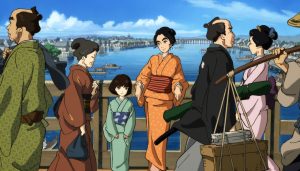
(Sight & Sound Magazine, BFI)
In recent years, the Japanese animated films which have reached British cinemas have tended to be Studio Ghibli products or films like them, such as The Wolf Children (2013) and Giovanni’s Island (2014). Miss Hokusai, though, has its own distinctive flavour, setting mundane adult relationships against a colourful period backdrop. The film takes place in nineteenth-century Edo (the city which will be renamed Tokyo), and deals with the daily life of the woman artist O-Ei, who is the daughter of the great Hokusai. A real person, O-Ei left a handful of pictures under her own name; the most famous is Night Scene in the Yoshiwara, Yoshiwara being a fabled red-light district. More controversially, some historians speculate that O-Ei created artworks attributed to Hokusai at the end of his life.
The film supports this suggestion, showing father and daughter working practically on top of each other in their pigsty of a workshop (“It gets too dirty, we move”), kneeling on a filthy tatami floor as they create marvels. O-Ei is presented as a striking woman without the usual anime cuteness; her protruding lower lip gives her a pugilistic presence, together with her no-nonsense voice by Watanabe Anne, the actor daughter of Watanabe Ken. O-Ei’s father, addressed as “Tetsuzo” (one of several names that Hokusai used), is a dishevelled, unsmiling curmudgeon whose relationship with his daughter seems strictly professional. But this is not especially a father-daughter film. It equally highlights O-Ei’s fond relationship with her blind little sister (who ‘paints’ her own mental pictures of the world) and her awkward, repressed attraction to a handsome rival artist.
The film is very episodic, reflecting the comic on which it’s based (Sarusuberi by the late women artist Sugiura Hinako). In particular, some episodes take unexpected turns into the supernatural, including a sequence set in Yoshiwara where O-Ei and Hokusai see a courtesan with an astral head, extruding from her real head like a snake. Another vignette involves a Boschian painting of hell which drives a woman insane with images of devils and skeletons; Hokusai ‘exorcises’ it by adding an image of the Buddha.
While these scenes are vivid, they digress too far for the film’s good, without increasing our understanding of O-Ei. The best character-based scene has O-Ei visiting a brothel to lose her virginity to an androgynous prostitute, only to be terrified by his impatient embrace. Disturbing and funny, it may remind viewers of the cartoon conquests of Pepe Le Pew. However, it’s the only scene which feels like it’s breaking new ground.
Directed by Hara Keiichi, Miss Hokusai is produced by Production I.G, which made its name internationally with the melancholy violence of Ghost in the Shell (1995), but has also moved into other areas. (Its co-founder Ishikawa Mitsuhisa has spoken of the studio making more “afternoon tea” subjects, as opposed to the “strong black coffee” of Ghost in the Shell.) After the impressionism of Ghibli’s The Tale of the Princess Kaguya (2013), Miss Hokusai’s solid realism feels conservative, shifting gently between measured, formal elegance and mostly mild irreverence. The tragic (but hardly unexpected) ending is far less moving than the shamelessly sentimental end of Giovanni’s Island, which was also made by Production I.G. Miss Hokusai aims for something less crude, and creates adult characters who are good company on screen, but the film isn’t subtle enough to get under their skin.
[amazon_link asins=’B017HM6PB6,B017HM6P8Y,B0723H78D7′ template=’ProductCarousel’ store=’anime04c-21′ marketplace=’UK’ link_id=’6aa90c9f-c851-11e8-b88b-5dfa5bdc329a’]
